A fresh batch of important monthly data on income, outlays, and personal consumption expenditure prices in the US has been published. Personal outlays grew by 0.2% in April after a 0.7% jump a month earlier. Incomes rose 0.3% following a 0.5% increase in the previous month. The savings-to-income ratio remained at 3.6% for the second month in a row, continuing its downward trend since last August. Persistently lower levels of this indicator were seen in 2005-2007 when the housing market was pulling finances out of US households. Currently, the pressure is being provided by a rebound in the tax burden after pandemic-related easing.
Economic Events:
Last week was marked by high-impact economic data from G7 nations, particularly the United States, which reported its GDP and PCE inflation figures. The US GDP growth rate was revised down to 1.3% for Q1, missing earlier estimates of 1.6%. This softer economic expansion, coupled with PCE inflation data aligning with expectations, influenced market expectations around future interest rate policies. These figures, along with remarks from Federal Reserve officials, shaped market sentiment and trading strategies.
By May last year, personal taxes had risen by 10%, resulting in a 4.5% rise in personal spending over the period but only a 3.7% rise in disposable income. Spending, on the other hand, increased by 5.5%. The Core PCE Price Index matched analysts’ expectations, adding 0.2% m/m and 2.8% y/y. The annual rate has remained unchanged for three consecutive months, exceeding the Fed’s target. However, the lack of acceleration is good news amid risks indicated by other inflation indicators.
The main threat to markets in the coming months is a slowdown in spending by US households. These households may shift to a more cautious spending pattern amid low savings rates, potentially repeating the 2005-2007 history. US economic growth rose a modest 1.3% in the first quarter, a softer increase compared to the government’s initial 1.6% estimate. The revised data reflects a sluggish pace of growth and the second straight quarterly downshift. However, the current nowcast for Q2 suggests that output will stabilize if not strengthen, based on the median for a set of estimates.

US economic activity is expected to increase by 2.0% in the April-through-June period, according to the median nowcast. If correct, this advance will mark a solid rebound in growth over Q1’s 1.3% rise and the first quarterly acceleration since Q3 2023. Today’s revised median Q2 nowcast aligns with recent estimates. For example, more than a week ago, the reported median nowcast was 1.9%.
For Q1’s weaker print, the key factor is related to a downside revision in consumer spending. In the initial estimate, goods outlays were reported to have contracted at a scant 0.4% annualized rate. All the weakness in the initial estimate was on the durable goods side, with non-durable good spending flat. Today’s revisions marked down those spending estimates significantly. Goods spending is now estimated to have contracted at a 1.9% annualized rate, including a 4.1% contraction in durable goods outlays and a 0.6% annualized drop in non-durable goods spending. These revisions align with downward revisions to Q1 retail sales, suggesting we may see some revision to monthly durable goods spending.
Recent data has highlighted that consumer spending has been softening. Retail sales in April, for example, were flat after two straight solid monthly gains. Given that consumer spending accounts for about 70% of US economic activity, the weak retail sales data raises questions about the outlook for the remainder of Q2. All of this ties back to the lagged effects of the Federal Reserve’s interest rate hikes over the past two years.

“The impact of the Fed’s tight interest rate policy is clearly visible in the first quarter GDP report,” says Bill Adams, chief economist at Comerica. For now, it’s not clear if the weaker Q1 data will spill over into Q2, or if the relatively upbeat nowcasts for the current quarter are overly optimistic. The incoming data for May will likely determine the accuracy of these forecasts.
Technology stocks have continued to lead the broader market higher in 2024, posting new highs. However, this is also why we closely watch the Nasdaq-related indices. When leadership is strong, the market tends to remain strong, but when leadership starts to falter, the chances of a stock market correction increase.
Gold (XAUUSD):
Gold prices reversed earlier gains, falling below $2,330 per ounce on Friday. This decline followed the PCE inflation figures, which matched expectations and provided the Federal Reserve some flexibility to potentially cut interest rates later in the year. As a result, market expectations for rate cuts in September, November, and December slightly increased. Despite the recent pullback, gold posted a 1.8% gain for May, marking its fourth consecutive monthly increase. Investors are now watching for central bank policy moves and inflation data to guide future gold price directions.
Indices:
Major indices experienced volatility amid mixed economic signals. The S&P 500 and Dow Jones Industrial Average saw fluctuations as investors digested the GDP revisions and inflation data. The tech-heavy Nasdaq Composite showed resilience, benefiting from lower bond yields and positive sentiment around potential Fed rate cuts. European indices mirrored this trend, with the Euro Stoxx 50 reacting to inflation data and ECB policy expectations.
Foreign Exchange Market (FOREX):
The forex market was notably active, with the US dollar index experiencing fluctuations driven by economic data and central bank commentary. The euro strengthened, reaching a two-week high against the dollar, as Eurozone inflation data suggested fewer ECB rate cuts than previously anticipated. The British pound also gained, surpassing $1.275, buoyed by easing US inflation data and shifting expectations for Bank of England rate cuts. Meanwhile, the Australian dollar approached four-month highs on strong domestic inflation data, and the Japanese yen appreciated due to safe-haven buying and rising domestic yields.
Bitcoin (BTC):
This week, Bitcoin ($BTC) is expected to provide an opportunity for bearish sentiment to return before continuing its upward trend.
The weekly candlestick has formed a nice long wick, and the perspective is that we are still in the phase similar to January 22nd, with BTC potentially reaching at least $80K.
However, the short-term volume after breaking the trendline is low, making it vulnerable to price manipulation by funds. Therefore, it is advisable to backtest for a few days.
Nevertheless, this trend does not support the double bottom pattern seen in many altcoins, so it’s better for BTC to continue its upward movement.
The opportunity to buy and hold occurred a few days ago. If you want to trade, it’s better to wait for a backtest before entering the market.
If you’re concerned about a significant dip to $52K, it is recommended to stick to your personal plan for a good and safe entry.
US Crude Oil WTI :
WTI crude futures dipped to around $77.5 per barrel, marking a third consecutive session of losses. The decline was driven by ongoing demand uncertainties and economic data pointing to a slower-than-expected growth pace in the US. The Energy Information Administration (EIA) reported a significant drop in US crude inventories by 4.2 million barrels, more than double the expected draw. However, a surprising rise in gasoline stockpiles by 2 million barrels indicated weak demand, dampening the bullish inventory news. Attention now turns to the upcoming OPEC+ meeting, where further supply cut extensions into 2025 are anticipated.
Outlook for Next Week:
Looking ahead, the financial markets will be influenced by several key economic events. Investors will closely watch the outcome of the OPEC+ meeting for any changes in oil production policies. Additionally, central bank meetings, particularly the ECB and Bank of Canada, will be pivotal in shaping market expectations. Economic data releases, including employment figures and inflation reports, will also play a crucial role in guiding investor sentiment and market direction.

Disclaimer: The views and opinions expressed in the blog posts on this website are those of the respective authors and do not necessarily reflect the official policy or position of Meta Trading Club Inc. The content provided in these blog posts is for informational purposes only and should not be considered as financial advice. Readers are encouraged to conduct their own research and consult with a qualified financial advisor before making any investment decisions. Meta Trading Club Inc shall not be held liable for any losses or damages arising from the use of information presented in the blog posts.













